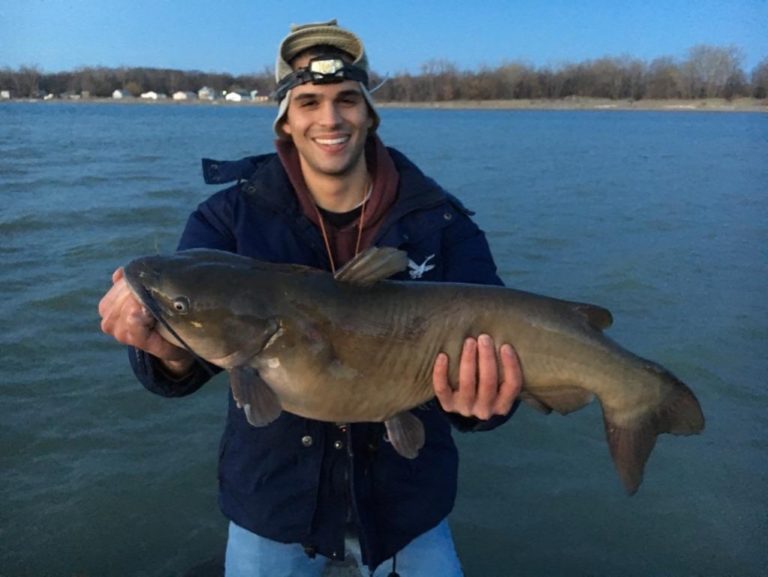The Channel Catfish

The channel catfish (Ictalurus punctatus) is a type of catfish found in large bodies of water throughout western New York. Channel catfish typically range between 20 and 30 inches in length and can be identified by their wide mouths, barbels (whiskers), smooth skin, and general catfish appearance. Channel catfish can range in color from light gray or brown to black. Small channel catfish have a sharp spine in each of its pectoral and dorsal fins that can puncture the skin if the fish is not grasped properly. However, the pectoral and dorsal spines on large channel catfish are usually dull. Contrary to the belief of some, the barbels of a channel catfish do not sting! They are used for sensing.
Channel catfish are not the only catfish in western New York and are often confused with bullhead. Brown, yellow, and black bullhead can all be told apart from channel catfish by the shape of their tail. All bullhead have a flat tail fin, while channel catfish have a forked tail fin. Channel catfish also grow much, much larger than any of the bullhead species.
Habitat
Channel catfish are warm-water fish, but generally do not inhabit water that becomes excessively warm. Channel catfish are found in large creeks, rivers, and large lakes. Channel catfish are usually not found in ponds or small lakes. In large creeks and rivers, channel catfish prefer the deep, sluggish stretches and for this reason are usually found in the lower sections of creeks (toward the creek mouth). Channel catfish can also be found in bays and inlets in lakes Erie and Ontario, especially in the spring.
Channel catfish usually hold close to the bottom and generally do not cruise the water column or feed top water. Channel catfish love cover and will hide in and around downed trees, undercut banks, or holes in the creek bed. Channel catfish usually remain in their hiding spots during the day and then move into open water at night to feed.
Food
A channel catfish’s diet primarily consists of smaller fish including minnows, bluegill, and even small bass or other sport fish. Channel catfish will also scavenge and eat dead fish, worms, and crustaceans.
Where to Catch Channel Catfish
Channel catfish are available in all counties of western New York, primarily in large bodies of water. Some large lakes (Silver, Chautauqua, etc.) may contain some channel catfish, but these aren’t the most popular places to target them. The best spots to look for channel catfish are large, deep, sluggish, turbid, warm-water creeks and rivers. Some creeks that fit the bill are 18 Mile Creek (Erie), Cattaraugus Creek, Ellicott Creek (lower), the Erie Canal, and the Buffalo River. Closer to Lake Ontario, 18 Mile Creek and the Oak Orchard River usually produce channel catfish. Bays and inlets on lakes Erie and Ontario are also good places to target channel catfish.
The best time of year to target channel catfish by far is the springtime. Usually starting in early April, big channel catfish move into large creeks from Lake Erie and Lake Ontario to spawn. The catfish run usually lasts until the end of June. At the end of June, large channel catfish begin to spawn and return to the deeper waters of Lake Erie or Ontario shortly thereafter. However, some channel catfish can be caught in large area creeks until mid to late summer. The channel catfish that remain for the summer are typically on the smaller side and can be more difficult to catch.

How to Catch Channel Catfish
Channel catfish are almost always caught on natural bait. The three most popular baits for channel catfish are cutbait, nightcrawlers, and chicken liver. These catfish baits can be fished on the bottom or under a float. A good rig for fishing on the bottom consists of a slab of cutbait, a whole nightcrawler, or a chicken liver sack on a large octopus or circle hook with a large sinker placed about 1-2 ft. from the hook. When fishing the bottom, cast you rig out, reel in the slack, and wait. It is best practice to wait 30-40 minutes before checking your bait. Fishing on the bottom is the best strategy at night. Add enough weight such that your rig does not move downstream with the current.
It is also possible to target channel catfish using a rig with a float. Float fishing for catfish is probably the best way to go when fishing during the day. A good float rig consists of a slip float, a large circle or octopus hook, and a sinker placed about a foot from the hook. Cutbait, nightcrawlers, and chicken liver sacks are all good baits for float rigs. When float fishing, cast your rig upstream and let it drift down through deep holes where catfish may be hiding. You should adjust the depth of your float so that your sinker just touches bottom as it drifts.
